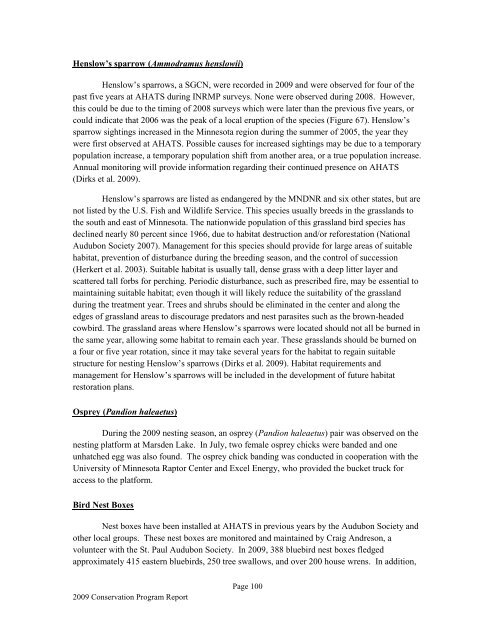camp ripley and arden hills minnesota army national guard training ...
camp ripley and arden hills minnesota army national guard training ...
camp ripley and arden hills minnesota army national guard training ...
Create successful ePaper yourself
Turn your PDF publications into a flip-book with our unique Google optimized e-Paper software.
Henslow’s sparrow (Ammodramus henslowii)<br />
Henslow‟s sparrows, a SGCN, were recorded in 2009 <strong>and</strong> were observed for four of the<br />
past five years at AHATS during INRMP surveys. None were observed during 2008. However,<br />
this could be due to the timing of 2008 surveys which were later than the previous five years, or<br />
could indicate that 2006 was the peak of a local eruption of the species (Figure 67). Henslow‟s<br />
sparrow sightings increased in the Minnesota region during the summer of 2005, the year they<br />
were first observed at AHATS. Possible causes for increased sightings may be due to a temporary<br />
population increase, a temporary population shift from another area, or a true population increase.<br />
Annual monitoring will provide information regarding their continued presence on AHATS<br />
(Dirks et al. 2009).<br />
Henslow‟s sparrows are listed as endangered by the MNDNR <strong>and</strong> six other states, but are<br />
not listed by the U.S. Fish <strong>and</strong> Wildlife Service. This species usually breeds in the grassl<strong>and</strong>s to<br />
the south <strong>and</strong> east of Minnesota. The nationwide population of this grassl<strong>and</strong> bird species has<br />
declined nearly 80 percent since 1966, due to habitat destruction <strong>and</strong>/or reforestation (National<br />
Audubon Society 2007). Management for this species should provide for large areas of suitable<br />
habitat, prevention of disturbance during the breeding season, <strong>and</strong> the control of succession<br />
(Herkert et al. 2003). Suitable habitat is usually tall, dense grass with a deep litter layer <strong>and</strong><br />
scattered tall forbs for perching. Periodic disturbance, such as prescribed fire, may be essential to<br />
maintaining suitable habitat; even though it will likely reduce the suitability of the grassl<strong>and</strong><br />
during the treatment year. Trees <strong>and</strong> shrubs should be eliminated in the center <strong>and</strong> along the<br />
edges of grassl<strong>and</strong> areas to discourage predators <strong>and</strong> nest parasites such as the brown-headed<br />
cowbird. The grassl<strong>and</strong> areas where Henslow‟s sparrows were located should not all be burned in<br />
the same year, allowing some habitat to remain each year. These grassl<strong>and</strong>s should be burned on<br />
a four or five year rotation, since it may take several years for the habitat to regain suitable<br />
structure for nesting Henslow‟s sparrows (Dirks et al. 2009). Habitat requirements <strong>and</strong><br />
management for Henslow‟s sparrows will be included in the development of future habitat<br />
restoration plans.<br />
Osprey (P<strong>and</strong>ion haleaetus)<br />
During the 2009 nesting season, an osprey (P<strong>and</strong>ion haleaetus) pair was observed on the<br />
nesting platform at Marsden Lake. In July, two female osprey chicks were b<strong>and</strong>ed <strong>and</strong> one<br />
unhatched egg was also found. The osprey chick b<strong>and</strong>ing was conducted in cooperation with the<br />
University of Minnesota Raptor Center <strong>and</strong> Excel Energy, who provided the bucket truck for<br />
access to the platform.<br />
Bird Nest Boxes<br />
Nest boxes have been installed at AHATS in previous years by the Audubon Society <strong>and</strong><br />
other local groups. These nest boxes are monitored <strong>and</strong> maintained by Craig Andreson, a<br />
volunteer with the St. Paul Audubon Society. In 2009, 388 bluebird nest boxes fledged<br />
approximately 415 eastern bluebirds, 250 tree swallows, <strong>and</strong> over 200 house wrens. In addition,<br />
2009 Conservation Program Report<br />
Page 100
















